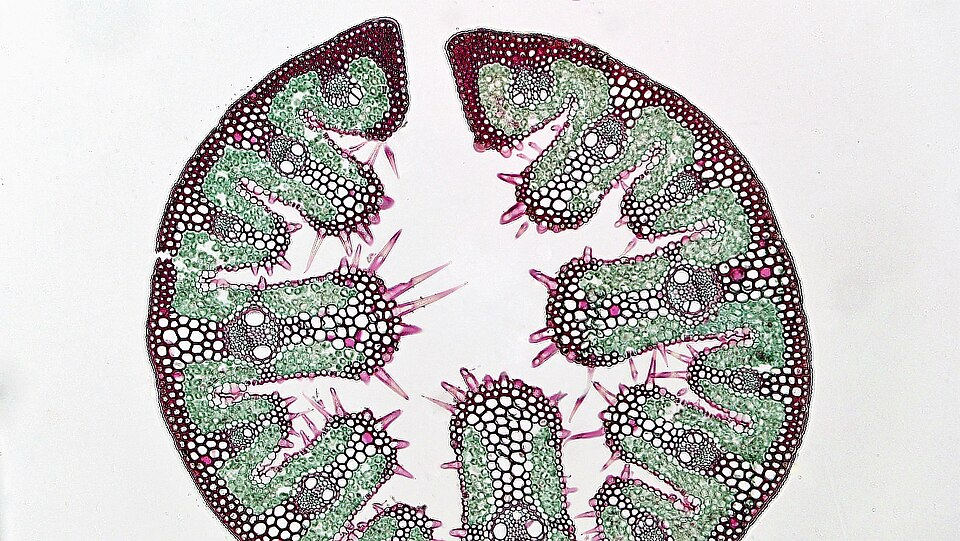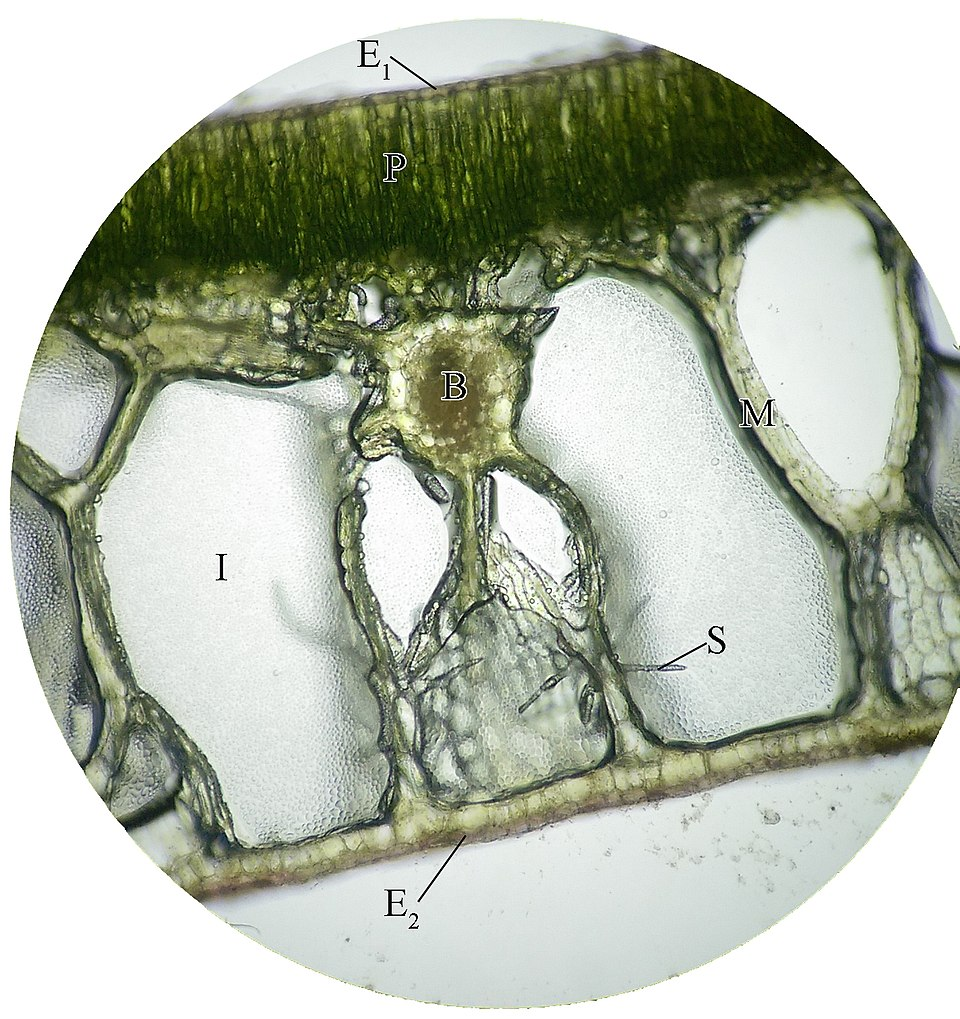OCR Specification focus:
‘Explain adaptations of xerophytes, including marram grass and cacti, and hydrophytes such as water lilies, relating structures to challenges of their habitats.’
Plants exhibit remarkable structural and physiological adaptations that enable survival across habitats with vastly different water availability. These include xerophytes in arid environments and hydrophytes in aquatic conditions, each with specialised features optimising water balance.
Xerophytes: Adaptations to Arid Environments
Xerophytes are plants adapted to survive in conditions of limited water availability, such as deserts, sand dunes, or exposed coastal areas. They face challenges of high evaporation rates, intense sunlight, and limited precipitation.
Structural Adaptations
1. Leaf Modifications
Reduced leaf surface area: Many xerophytes have needle-shaped or rolled leaves (e.g., marram grass) to minimise water loss through transpiration.
Thick cuticle: A waxy, waterproof layer covering the epidermis reduces evaporative water loss.
Sunken stomata: Stomata located in pits trap humid air, decreasing the water potential gradient between the leaf and the environment.
Hairy leaves: Leaf hairs form a boundary layer of still, moist air, reducing transpiration rates.
Leaf rolling: Marram grass rolls its leaves so that stomata are enclosed within a humid microenvironment, further conserving moisture.

Cross-section of a rolled marram grass (Ammophila arenaria) leaf illustrating xerophytic adaptations that limit transpiration. The inward-facing stomatal region and infolded inner surface help trap humid air, while robust epidermal and supportive tissues reduce water loss. Labels may include epidermis, vascular bundles, and mesophyll; minor extra histological detail is shown beyond the OCR essentials. Source.
2. Stomatal Control
Xerophytes often exhibit stomatal closure during the hottest parts of the day to reduce transpiration.
Some species open stomata only at night, using Crassulacean Acid Metabolism (CAM) for carbon fixation.
Crassulacean Acid Metabolism (CAM): A photosynthetic adaptation in which stomata open at night to take in carbon dioxide, stored as malic acid, and close during the day to conserve water.
3. Succulence
Many xerophytes, like cacti, store water in succulent tissues such as stems or leaves.
The parenchyma cells of these tissues have large vacuoles for water storage, allowing survival during prolonged droughts.
4. Root Adaptations
Extensive shallow root systems spread widely to absorb rain quickly before it evaporates.
Alternatively, deep taproots reach underground water sources.
For instance, cacti often possess both surface roots and deep roots, maximising water acquisition.
5. Photosynthetic Adaptations
Some xerophytes conduct photosynthesis in stems rather than leaves to reduce leaf surface area and water loss.
The stomatal density is often lower to further conserve water.
Physiological Adaptations
1. Water Storage and Retention
Xerophytes store mucilaginous water-retentive compounds in cells to maintain hydration.
High concentrations of solutes in cells help maintain osmotic balance, drawing water into cells and preventing plasmolysis.
2. Dormancy and Leaf Shedding
Some xerophytes shed leaves during dry seasons to minimise transpiration.
Others enter metabolic dormancy, reducing growth and water usage until conditions improve.
3. Metabolic Adaptations
Many desert plants utilise C4 photosynthesis, a pathway that increases the efficiency of carbon fixation while reducing water loss.
C4 Photosynthesis: A photosynthetic mechanism where carbon dioxide is initially fixed into a four-carbon compound, allowing efficient photosynthesis under high temperatures and low water availability.
4. Osmoregulation and Solute Accumulation
Xerophytes accumulate compatible solutes like proline or sugars that lower cell water potential without disrupting metabolism.
This enhances water uptake and maintains cell turgidity under drought stress.
Examples of Xerophytes
Marram Grass (Ammophila arenaria)
Found on sand dunes with low water retention and strong winds.
Rolled leaves trap moist air; stomata on inner surface are protected from desiccation.
Thick cuticle and dense hairs reduce transpiration.
Deep roots anchor the plant and absorb moisture from lower soil layers.
Cactus (Opuntia spp.)
Succulent stems store water and perform photosynthesis.
Spines replace leaves, providing shade and protection while reducing surface area.
CAM metabolism conserves water by separating gas exchange temporally.
Extensive root system ensures rapid water uptake following rare rainfall.
Hydrophytes: Adaptations to Aquatic Environments
Hydrophytes are plants adapted to living in or on water, where water availability is abundant but gas exchange and support present challenges.
Structural Adaptations
1. Large Air Spaces (Aerenchyma)
Aerenchyma tissue provides buoyancy and enables gas diffusion between aerial and submerged parts.
Common in water lilies and lotus plants, facilitating oxygen transport to roots submerged in anaerobic mud.
Aerenchyma: A plant tissue containing extensive intercellular air spaces that aid buoyancy and internal gas transport in aquatic plants.
2. Reduced or No Cuticle
As water loss is not a problem, hydrophytes possess thin or absent cuticles, allowing free diffusion of gases and water.
3. Stomatal Distribution
Stomata located on the upper leaf surface allow direct gas exchange with the atmosphere in floating leaves, e.g., water lily leaves.
Submerged leaves lack stomata entirely and rely on diffusion across the epidermis.

Cross-section of a water lily (Nymphaea) leaf showing upper epidermal stomata suited to floating leaves and large aerenchyma air spaces for internal gas transport and buoyancy. Palisade tissue lies beneath the upper epidermis; vascular bundles traverse the mesophyll. The image includes labelled histological abbreviations, which exceed the minimum syllabus detail but remain educational. Source.
4. Flexible Stems and Leaves
Lack of lignified tissue allows flexibility, reducing damage from water currents.
Supporting tissues are minimal, as water provides buoyancy.
5. Leaf Morphology
Broad, flat leaves maximise exposure to sunlight for photosynthesis.
Chloroplasts concentrated in the upper mesophyll optimise light capture.
Physiological Adaptations
1. Reduced Vascular Tissue
Xylem vessels are reduced since water transport is less necessary; phloem remains functional for nutrient distribution.
2. Gas Exchange and Oxygen Diffusion
Internal air channels facilitate movement of gases, ensuring root respiration even in anoxic sediments.
Some hydrophytes release oxygen bubbles into the water through stomata.
3. Reproductive Adaptations
Many hydrophytes have floating flowers or pollen adapted for water dispersal.
Seeds may float to aid colonisation of new aquatic areas.
Examples of Hydrophytes
Water Lily (Nymphaea spp.)
Large, flat leaves float on the surface to access sunlight.
Stomata on upper surfaces for efficient gas exchange.
Long petioles connect leaves to submerged roots, containing aerenchyma for buoyancy.
Elodea
Submerged leaves with thin cell walls and no cuticle for direct gas exchange.
Reduced xylem and high internal gas spaces assist survival in fully aquatic environments.
Comparative Summary of Xerophyte and Hydrophyte Adaptations
Xerophytes conserve water through reduced surface area, thick cuticles, and specialised metabolism.
Hydrophytes adapt to abundant water with reduced support tissues, open gas spaces, and modified stomata placement.
Both groups exemplify evolutionary specialisation to maintain homeostasis under contrasting environmental conditions.
FAQ
Both adaptations reduce transpiration, but their structures differ slightly.
Sunken stomata are openings positioned below the leaf surface, often in pits or grooves, where water vapour becomes trapped, lowering the diffusion gradient.
Stomatal crypts are deeper chambers lined with hairs where multiple stomata open into a small cavity. The trapped moist air and hairs reduce airflow and evaporation even more effectively.
This added complexity makes stomatal crypts particularly efficient in extreme xerophytic species such as oleander.
Reflective or light-coloured surfaces help to reduce heat absorption and thus lower the rate of water evaporation. The reflectivity, often caused by waxy coatings, hairs, or salt crystals, decreases the amount of solar radiation absorbed by the leaf.
This adaptation is common in desert plants like cacti or halophytes that experience intense sunlight and high temperatures, where limiting leaf temperature directly reduces transpiration losses.
Hydrophytes use extensive aerenchyma tissue to form continuous air channels from aerial parts to submerged roots. Oxygen diffuses through these intercellular spaces to support aerobic respiration in root cells.
In some species, gases flow by pressurised ventilation—oxygen produced during photosynthesis increases gas pressure, pushing air towards roots. This mechanism prevents root death in oxygen-poor, waterlogged sediments.
Succulence also serves temperature regulation and photosynthetic stability.
Water-filled tissues buffer temperature fluctuations, protecting enzymes from heat stress.
Large parenchyma cells maintain turgor and keep stomata functional during drought.
Some succulents store CO₂ as organic acids, allowing photosynthesis to continue with closed stomata.
This multifunctional role makes succulence a cornerstone of survival in hot, arid ecosystems.
In floating hydrophytes like water lilies, waxy cuticles on the upper surface prevent leaves from becoming waterlogged rather than reducing transpiration. The wax layer also helps repel water, keeping stomata clear for gas exchange and allowing light penetration for photosynthesis.
Thus, while xerophytes use wax for water retention, hydrophytes use it for water repellence and gas exchange efficiency—a contrasting but equally vital adaptation.
Practice Questions
Question 1 (2 marks)
Explain how the leaf structure of marram grass reduces water loss in its natural habitat.
Mark scheme:
1 mark for mentioning rolled leaves trap moist air, reducing the water potential gradient between the inside and outside of the leaf.
1 mark for describing that stomata are located on the inner surface within the rolled leaf, protecting them from direct exposure to dry air or wind.
Question 2 (5 marks)
Compare and contrast the adaptations of xerophytes and hydrophytes that enable them to survive in their respective environments.
Mark scheme:
1 mark for stating that xerophytes are adapted to minimise water loss, whereas hydrophytes are adapted to maximise gas exchange and buoyancy in water.
1 mark for correctly describing a xerophyte adaptation such as thick cuticle, sunken stomata, or succulent tissues.
1 mark for correctly describing a hydrophyte adaptation such as large air spaces (aerenchyma) or stomata on upper surfaces.
1 mark for a clear comparison between opposing adaptations (e.g. xerophytes have reduced surface area to limit water loss, hydrophytes have broad leaves to increase photosynthesis).
1 mark for using specific named examples (e.g. Ammophila arenaria for xerophyte, Nymphaea for hydrophyte) or providing an accurate explanation linking adaptation to environmental challenge.

